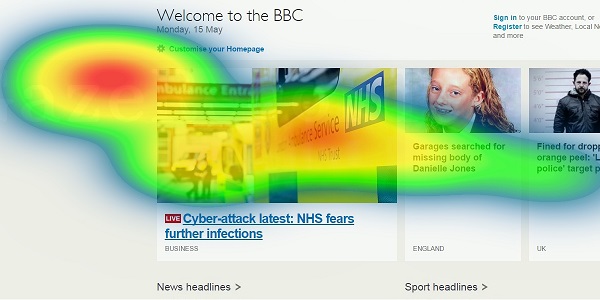
June 14, 2017, by Stuart Moran
Use of Affordable Eye Tracking in News Verification Strategies
The Digital Research team are facilitating a collaboration between Schools of Sociology and Social Policy, and Computer Science to explore fake news in social media.
Having completed a survey which explored user perceptions of fake news, we are now about to begin a series of studies looking more closely at the ways people assess digital news articles.
Information is typically consumed very quickly when presented through social media – consider how fast you might browse through your own Facebook or Twitter feeds. We believe a series of value judgements are made by users in very short periods of time which determine how they engage with that information. They might ignore it, share it, reflect on it or want to learn more about it.
How do we best capture the order and target of these micro-decisions and judgements? Observations and self-reporting are two options we aim to adopt, but given the speed and number of decisions made it is difficult to see how these would truly capture what is happening.
This prompted us to explore how Eye Tracking technology might be able to act as a supplementary data source. Eye Tracking devices typically make use of infrared cameras to track pupil movement, and translate these into co-ordinates on the computer or phone screen. This allows us to observe precisely where users are looking on the screen and in real-time.
One of the major barriers to entry are the high costs associated with the devices and analytical software – this can be upwards of £25,000. For this research, we do not need the levels of precision afforded by these high-end devices, and are looking for more general trends. This allowed us to explore the availability of less precise but more affordable eye tracking devices.
After some brief searching, there really only seemed to be one device that was suitable for our purposes and within our price range. The GazePoint Eye Tracker costs around £1,500 and has a surprising level of accuracy.
The tracker can capture data up to 150Hz, and includes some basic software (that can be upgraded). The software allows researchers to visualise the data in terms of fixation points and lines connecting them, or a set of heatmaps that give broad trends. The screen, webcam video, device video and audio can all be captured at the same time and exported in a video format.
Gazepoint is also supported by the open source PyGaze eye tracking software, which gives us the opportunity to adapt and customise the software in the future.
Next steps are for us to begin our trials using the eye tracker. We have created a fake Facebook profile, and have included a range of real and fake news articles. Participants will be tasked with reviewing the news feed trying to identify the fake news while thinking aloud. The eye tracking data will be used to prompt discussion about the order with which information is consumed, and the verification strategies adopted.
If you are interested in eye tracking technologies, or would like to borrow and trial the GazePoint EyeTracker, please get in touch with the Digital Research Team.
Previous blog in series: Surveying traditional and digital consumption of fake news
Next blog in series: Fake News Research Study Outcomes and Reflection
Stuart Moran, Digital Research Specialist for Social Sciences
No comments yet, fill out a comment to be the first

Leave a Reply